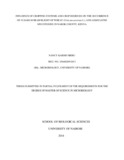| dc.description.abstract | Wheat (Triticum aestivum L.) is an important cereal grain cultivated worldwide. Fusarium head
blight (FHB) and the associated mycotoxins pose a threat to food security and safety in Kenya,
as they cause quantitative and qualitative yield losses, deterioration of grain nutritional value and
human and animal health risks. This study assessed the effect of cropping systems and the role of
soil and crop residues on the occurrence of FHB and associated mycotoxins in Narok County of
Kenya. A field survey covering 51 wheat farms was carried out between June and October 2013.
A semi structured questionnaire was used to obtain information on wheat production practices.
Top soil, crop residues and wheat spikes were sampled at hard dough stage while kernels were
sampled at harvest. The incidence of FHB was determined as the number of blighted heads over
the total number of heads within 1m2 randomly selected quadrants in each farm, while severity
was assessed based on proportion of bleached spikelets. Fusarium head blight-causing pathogens
were isolated from the soil, crop residues, spikelets and wheat kernels by plating on low strength
Potato Dextrose Agar (PDA) and the isolated Fusarium spp. were identified using cultural and
morphological characteristics. Two Fusarium mycotoxins, deoxynivalenol (DON) and T-2 toxin
in the wheat kernels were analyzed by competitive Enzyme Linked Immuno-Sorbent Assay
(ELISA).
Most (>50%) of the wheat farmers were small scale producers who used farm saved seeds,
rotated wheat with maize, grew the two crops side by side, grew wheat in consecutive years, left
wheat residues as standing hay for livestock and used simple land preparation methods that did
not burry previous crop residues. Prevalence of FHB at hard dough stage was 100% while the
mean incidence and severity of the disease ranged from 1 to 100% and 1 to 95%, respectively.
Fusarium spp. were most prevalent in crop residues; Aspergillus spp. and Penicillium spp. in
soil; and Epicoccum spp. and Alternaria spp. in wheat ears and kernels. The isolation frequency
of the fungal pathogens in crop residues, soil, wheat ears and kernels at harvest significantly (p ≤
0.05) varied among the agro-ecological zones. The most frequently isolated Fusarium spp. were
F. chlamydosporum (2.6%) and F. graminearum (2.0%) in crop residues, F. oxysporum (3.4%)
and F. proliferatum (2.5%) in soil; F. avenaceum (3.0%) and F. poae (1.9%) in wheat ears; and
F. tricintum (4.4%) and F. poae (2.9%) in wheat kernels. The incidence of the Fusarium spp. in
crop residues, soil and wheat ears varied significantly (p ≤ 0.05) among the agro-ecological zones but there was no significant (p ≥ 0.05) difference in the incidence of Fusarium spp. in
wheat kernels at harvest. All the wheat kernels were contaminated with T-2 toxin while 94%
were contaminated with deoxynivalenol. The concentration of T2-toxin in the kernels ranged
from 8.8 to 37 µg/kg (mean = 25.1 µg/kg) while that of DON ranged from below limit of
detection (18.5 µg/kg) to 114 µg/kg (mean = 9.1 µg/kg). The results of this study implied that
wheat production practices affect the incidence and severity of FHB and that the disease is
caused by a complex of Fusarium spp. The Fusarium spp. survive in soil and crop residues
between cropping seasons thereby providing primary inocula for FHB in a subsequent wheat
crop. Although all the wheat kernels were contaminated with T-2 toxin and 94% were
contaminated with deoxynivalenol, the toxin levels were within the limits set by the European
Commission (EU) and the United States Food and Drug Administration (FDA). This implied that
the wheat harvested during the 2013 cropping season in Narok County was safe for human
consumption and therefore posed no health risk to humans and livestock. The low incidence of
Fusarium spp. in spikelets and kernels at harvest could explain the low incidence and severity of
FHB in the field and the low levels of DON and T-2 toxin in harvested wheat kernels. It is
recommended that inclusion of maize as a rotation crop in wheat production and leaving crop
residues on the soil surface after harvesting should be avoided. Additionally, farmers should be
encouraged to apply recommended fungicides in the management of FHB; while continuous
monitoring and surveillance of DON and T-2 toxin levels in wheat should be promoted. Further
studies on the long-term effect of various wheat production practices on FHB are also
recommended.
Key words: Cropping systems, Fusarium head blight, mycotox | en_US |

